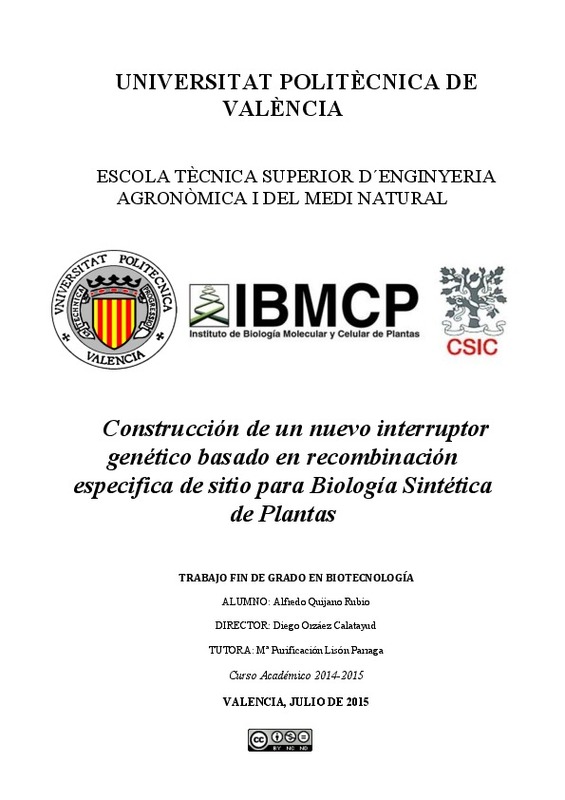JavaScript is disabled for your browser. Some features of this site may not work without it.
Buscar en RiuNet
Listar
Mi cuenta
Estadísticas
Ayuda RiuNet
Admin. UPV
Construcción de un nuevo interruptor genético basado en recombinación especifíca de sitio para Biología Sintética de Plantas
Mostrar el registro sencillo del ítem
Ficheros en el ítem
| dc.contributor.advisor | Lisón Párraga, María Purificación
|
es_ES |
| dc.contributor.advisor | Orzáez Calatayud, Diego Vicente
|
es_ES |
| dc.contributor.author | Quijano Rubio, Alfredo
|
es_ES |
| dc.date.accessioned | 2015-09-07T15:59:52Z | |
| dc.date.available | 2015-09-07T15:59:52Z | |
| dc.date.created | 2015-07-17 | |
| dc.date.issued | 2015-09-07 | es_ES |
| dc.identifier.uri | http://hdl.handle.net/10251/54374 | |
| dc.description.abstract | [ES] La Biología Sintética de Plantas es una disciplina emergente que propone el empleo de los principios de ingeniería para desarrollar nuevas funciones en organismos vegetales, tales como la introducción de una nueva ruta metabólica o la producción de proteínas recombinantes. Estas funciones "sintéticas" a menudo producen una tara en el crecimiento si se encuentran activadas constitutivamente. Por ello se crea la necesidad de equipar a las plantas con interruptores y pequeños circuitos genéticos que permitan activar o desactivar estas nuevas funciones sintéticas cuando sea necesario. En este trabajo se construirá un interruptor genético basado en recombinación específica de sitio para el estrecho control de estas nuevas funciones mediante el método de ensamblaje modular GoldenBraid 2.0, diseñado para Biología Sintética de Plantas, y se comprobará su funcionamiento mediante transformación transitoria y estable de Nicotiana benthamiana. | es_ES |
| dc.description.abstract | [EN] The recent onset and expansion of Synthetic Biology has opened a new technological horizon based on the design of living organisms with novel biological functions. Nevertheless, these novel functions often involve toxic effects or suppose a metabolic burden for these organisms, hindering their normal development. As a consequence, the design and creation of new elements for the control of genetic expression is necessary to regulate these functions. Such elements are called genetic switches and there are different types of them depending on their characteristics. Particularly, bistable and reversible genetic switches have proven to be noticeably useful due to their ability to modify the state of a given biological system and maintain this new state indefinitely. This state can only be reversed due to the presence of a new induction signal that is able to catalyze the return of the system to its initial state. Therefore, they provide the tool to induce and maintain a given biological condition until it is no longer necessary. One of the most suitable mechanisms for the design of this type of genetic switches is the renowned site-specific recombination, which provides a quick and efficient DNA modification mechanism. On the other hand, different modular DNA assembly systems have been recently developed. They are based on the use of DNA standard parts as building blocks for the construction of complex DNA structures. Large collections of parts with different functions are being created, giving the possibility to exchange and use these DNA parts all over the world. As a consequence, the modular and standard design of genetic elements, as genetic switches, is essential for to make them easy to use, adaptable and reusable, providing solutions to any biotechnological demand. Particularly, Plant Synthetic Biology is a very promising emerging discipline. Plants’ metabolic capabilities confer them unique properties that can be used in countless of applications in very diverse fields, for instance in bioremediation or the production of highvalue pharmaceutical products. However, the number of functional genetic switches for plants is still very limited. Therefore, the creation of new genetic switches for plants is essential for the development of Plant Synthetic Biology. In this project, the design, construction and testing of a novel bistable and reversible genetic switch for Plant Synthetic Biology were performed. This genetic switch is based on sitespecific recombination of integrase Bxb1 and is built following GoldenBraid 2.0, a widely used plant modular assembly standards. The functional characterization of the switch was performed by transient and stable transformation of Nicotiana benthamiana. the results obtained indicate that, upon optimization, this new genetic switch has the potential to become an important tool for Plant Synthetic Biology. | es_ES |
| dc.language | Español | es_ES |
| dc.publisher | Universitat Politècnica de València | es_ES |
| dc.rights | Reconocimiento - No comercial - Sin obra derivada (by-nc-nd) | es_ES |
| dc.subject | Biología Sintética de Plantas | es_ES |
| dc.subject | Interruptor genético | es_ES |
| dc.subject | Recombinación específica de sitio. | es_ES |
| dc.subject | Plant Synthetic Biology | es_ES |
| dc.subject | Genetic switch | es_ES |
| dc.subject | Site-specific recombination | es_ES |
| dc.subject.classification | BIOQUIMICA Y BIOLOGIA MOLECULAR | es_ES |
| dc.subject.other | Grado en Biotecnología-Grau en Biotecnologia | es_ES |
| dc.title | Construcción de un nuevo interruptor genético basado en recombinación especifíca de sitio para Biología Sintética de Plantas | es_ES |
| dc.type | Proyecto/Trabajo fin de carrera/grado | es_ES |
| dc.rights.accessRights | Abierto | es_ES |
| dc.contributor.affiliation | Universitat Politècnica de València. Escuela Técnica Superior de Ingeniería Agronómica y del Medio Natural - Escola Tècnica Superior d'Enginyeria Agronòmica i del Medi Natural | es_ES |
| dc.contributor.affiliation | Universitat Politècnica de València. Departamento de Biotecnología - Departament de Biotecnologia | es_ES |
| dc.description.bibliographicCitation | Quijano Rubio, A. (2015). Construcción de un nuevo interruptor genético basado en recombinación especifíca de sitio para Biología Sintética de Plantas. http://hdl.handle.net/10251/54374. | es_ES |
| dc.description.accrualMethod | TFGM | es_ES |
| dc.relation.pasarela | TFGM\28150 | es_ES |
Este ítem aparece en la(s) siguiente(s) colección(ones)
-
ETSIAMN - Trabajos académicos [3301]
Escuela Técnica Superior de Ingeniería Agronómica y del Medio Natural






